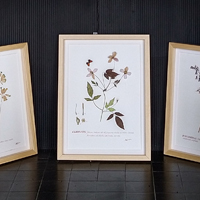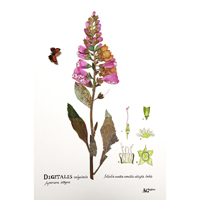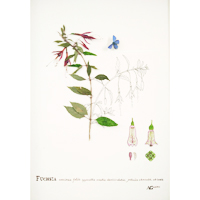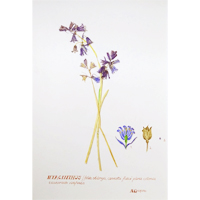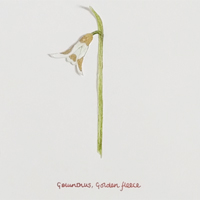Herbaria
The series of botanical collages presented in this installation engages in a critical dialogue with the visual and intellectual traditions of eighteenth-century natural history, particularly herbaria, botanical illustration, and the paper mosaics of The Widow, Mary Delany (1700-1788). Constructed using a combination of pressed flowers, hand-painted paper cut-outs, and fine line drawing, these works function simultaneously as homage and critique replicating the compositional logic of botanical documentation while actively disrupting its epistemological certainties. By weaving together historically coded forms of feminine craft and scientific observation, these works interrogate the gendered exclusions that have shaped the history of botanical knowledge production.
Golden Ovaries
Golden Ovaries engages with the snowdrop (Galanthus) as a lens through which to interrogate femininity, reproduction, and the aesthetics of classification. The work comprises a series of paper collages of hybrid snowdrops each one labeled with its varietal name. Where the ovary of each of these varieties in nature is yellow, in this work gold leaf is applied, drawing the eye to the reproductive site of the flower. This intervention reframes the flower as both an object of scientific scrutiny and of eroticised attention, aligning it with broader cultural discourses around femininity, fertility, and value.
The snowdrop, while modest in size and colouration, carries within horticultural subcultures and an often under-acknowledged symbolic status. Galanthophiles, collectors and enthusiasts of snowdrops, have been known to pay hundreds or even thousands of pounds for a single bulb of a rare variety. For example, a bulb of the Galanthus plicatus 'Golden Fleece' fetched £1,390 at auction in 2015, with others commanding similarly high sums. This phenomenon draws a direct line between botanical rarity and economic fetishism, where aesthetic distinctiveness, often reduced to a subtle difference in petal shape, leaf variegation, or in this case, ovary colour, is transmuted into capital. The deployment of gold leaf in this work literalises this conversion: the ovary becomes both site of reproduction and of economic value, simultaneously sacred and commodified.
